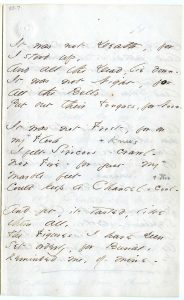It was not Death, for
I stood up,
And all the Dead, lie down –
It was not Night, for all
the Bells
Put out their Tongues, for Noon.
It was not Frost, for on my +Flesh + Knees
I felt Siroccos – crawl –
Nor Fire – for just my+ marble feet +tw0
Could keep a Chancel, cool –
And yet, it tasted, like
them all,
The Figures I have seen
Set orderly, for Burial,
Reminded me, of mine –
As if my life were shaven,
And fitted to a frame,
And could not breathe
without a key,
And ’twas like Midnight,
some –
When everything that ticked –
has stopped –
And space stares – all around –
Or Grisly frosts – first Au –
tumn morns,
Repeal the Beating Ground –
But, most, like Chaos –
Stopless – cool –
Without a Chance, or spar –
Or even a Report of Land –
To justify – Despair.
Link to EDA manuscript. Originally in Amherst Manuscript #fascicle 85. First published in Poems (1891), 222-23, with the alternatives not adopted. Courtesy of Amherst College, Amherst, MA.
Franklin dates this poem to summer 1862. Dickinson copied it into Fascicle 17. It is not usually considered a poem about the Civil War, but we follow Cristanne Miller’s lead in putting it into a war context, especially in relation to Dickinson’s response to the death of Frazar Stearns.
This harrowing poem revolves around an unnamed state, “It,” and what It is “not.” Definition through negative, as if the speaker’s state of feeling is so extreme, it cannot be named. The critical history of reading this poem draws on the biographical context of Dickinson’s suffering in love, her religious despair, her morbid response to death, or takes the poem to illuminate such aspects of her biography. But what if the poem’s speaker were a soldier traumatized by the horrendous experience of death and mutilation, which we know characterized Civil War battles? What if the poem were Dickinson’s attempt to dramatically capture the effects of that experience?
Maryanne Garbowsky comes close to this when she sees the poem paralleling “a panic attack in its physiological symptoms and its episodes of depersonalization where the victim is numb from extreme fear.” The speaker’s reference in stanza 1 to “all the dead” suggests not just one corpse in a coffin, as at a funeral, but many piled up or as the speaker says in stanza 3 “set orderly, for Burial,” as they would be in the aftermath of a battle, whether victory or defeat. Several photographs of Civil War battles illustrate just this kind of scene. Men in battle also describe time and sound stopping, and “chaos” taking over. And finally, the word “repeal” appears, in a slightly different form, in another poem of this period, which we discussed in the very first post and is most certainly about the war: “They dropped like Flakes” (F545A, J409). Dickinson’s first editors published this poem with the title, “The Battle-Field:”
They perished in the seamless Grass –
No eye could find the place –
But God can summon every face
On his Repealless – List.
Miller concludes:
Nothing makes this a war poem, and yet it powerfully evokes a state those who have survived battle might recognize.
Sources
- Miller, Cristanne. Reading in Time: Emily Dickinson in the Nineteenth Century. Amherst: University of Massachusetts Press, 2012, 164-65.
- Garbowsky, Maryanne. The House without a Door: A Study of Emily Dickinson and the Illness of Agoraphobia. Rutherford, N: Farleigh Dickinson University Press, 1989, 112-13.



